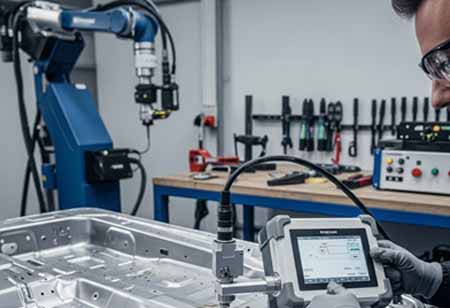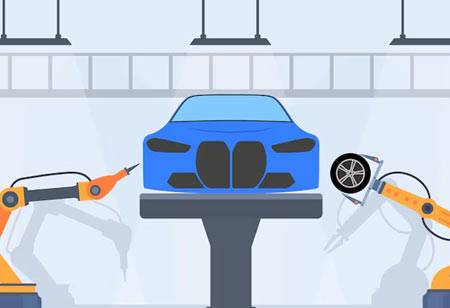THANK YOU FOR SUBSCRIBING
THANK YOU FOR SUBSCRIBING
Be first to read the latest tech news, Industry Leader's Insights, and CIO interviews of medium and large enterprises exclusively from Auto Tech Outlook

By
Auto Tech Outlook | Monday, October 06, 2025
Stay ahead of the industry with exclusive feature stories on the top companies, expert insights and the latest news delivered straight to your inbox. Subscribe today.
Maintaining constant quality and structural integrity is still an underlying principle in the changing automotive manufacturing world. Spot welding has been on the critical list of joining methods for sheet metal components in vehicle body assembly. The assurance of the strength of these welds is not just quality assurance but a matter of utmost importance for vehicle safety and performance. With increasingly complex designs and broader use of light materials, the evaluation methods for spot welds have transitioned to meet the new technical and regulatory demands.
New Approaches to Spot Weld Quality Testing
The most traditional methods to test spot welds have been mostly destructive, relying heavily on peeling testing and cross-sectioning. While these methods certainly give the most direct impression of weld strength and nugget formation ideas, they also destroy or significantly mark test specimens, increasing costs and time. Thus, manufacturers and designers are looking more toward non-destructive techniques (NDT), which preserve the integrity of the component but give an accurate reading.
Ultrasonic and electromagnetic tests are widely practiced for the real-time assessment of welding quality in manufacturing. The ultrasonic systems recognize discrepancies, voids, or incomplete fusion using sound waves reflected throughout the weld material. The electromagnetic technique measures changes in electrical conductivity, which allows manufacturers to conduct tests online as production is being carried out. With improvements in imaging technologies and sensor integration, other approaches for spot weld testing were developed, allowing surface and subsurface analysis. Such tools foster data-oriented quality assurance, complying with industry standards and adjusting processes.
Material Variability and Joint Complexity
As automotive manufacturers increasingly utilize high-strength steels and lightweight alloys, spot weld testing challenges are growing. Such materials present unique issues concerning weld formation and heat, thus impacting the accuracy and reliability of testing methods. For instance, high-strength steel may have small weld nuggets that are more technically challenging to detect and measure. Conversely, aluminum alloys require close monitoring of consistency in welding because of the high thermal conductivity and oxide layer formation.
Furthermore, multi-material joints and advanced joining techniques require testing solutions capable of populating a spectrum of material behaviors and properties along various weld configurations. Consequently, engineers need to consider the adaptability of testing protocols for geometry, thickness, and surface treatment modifications. This calls for increased attention to simulation and modeling tools with which the design phase predicts weld performance and potential for failure. Such predictive capabilities suggest a much more focused approach towards inspection strategies by reducing the scope of testing and moving towards a more productive testing scenario.
The other pertinent factor influencing spot-weld testing arises from the ongoing build-out of production automation systems. Robotic welders with intelligent monitoring facilities can monitor real-time process variables like current, pressure, and time. The combination of this data and the outputs from testing allows manufacturers to correlate their understanding of weld integrity with process performance. However, giving testing systems versatility from different points of automation systems and cultures of varied production speed is an area to keep focus on continuously.
Data Management and Analytics
Another field that remains paramount in achieving long-term quality goals is managing and interpreting the test data, away from the technical aspect. As such, inspection systems generate more input data, and the need to organize, analyze, and act on this data grows. Current software platforms provide a holistic aggregation of weld test results across different production lines and locations, thus presenting a centralized real-time monitoring dashboard where the data can be historically viewed.
Utilizing statistical prosthetics and machine-learning algorithms, trends can be tracked, deviations quickly apparent, and corrective actions undertaken by manufacturers. These applications ultimately form an underlying strategy for predictive maintenance, whereby test data is utilized for early warning to call for maintenance regarding preventing defects. Thus, the data obtained through spot weld testing are measures of present quality and a measure for improving future performance.
Proper data integration would assure compliance with documentation and regulations attached to customer specifications. Manufacturers could use the detailed record of weld test results for traceability to demonstrate that they adhered to the specification. This transparency increases competitiveness among suppliers and is also essential for obtaining certifications for safety-critical applications like structural frames and crash management systems.
Notwithstanding changes in automotive production, spot weld testing will remain an integral aspect of quality assurance. The continued development of ever more refined, responsive, and intelligent systems for conducting tests commits itself now to precision and absolute reliability at every stage of the manufacturing process. In addressing the technical and operational challenges of contemporary vehicle assembly, advanced testing of welds adds critical value to ensure that structural integrity remains uncompromised at every moment.
 Copyright © 2025 AutoTech Outlook. All Rights Reserved | Privacy Policy | Subscribe | Sitemap | About us | Feedback Policy | Editorial Policy
Copyright © 2025 AutoTech Outlook. All Rights Reserved | Privacy Policy | Subscribe | Sitemap | About us | Feedback Policy | Editorial Policy 



